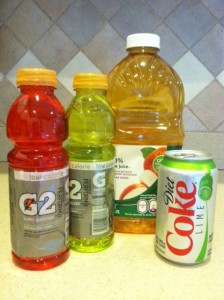 We often concern ourselves with the amount of calories in our foods, but what about in our drinks? When calorie-counting, are you accounting for the 140 calories in the orange juice you had with your breakfast this morning? Or the 150 calories of whole milk you added to your cereal?
We often concern ourselves with the amount of calories in our foods, but what about in our drinks? When calorie-counting, are you accounting for the 140 calories in the orange juice you had with your breakfast this morning? Or the 150 calories of whole milk you added to your cereal?
Fruit juices, caffeinated beverages, alcohol, and milk are all sources of liquid calories, that, when accumulated, account for much of our daily caloric intake.
The following breaks down and puts into perspective how much these beverages add to our daily calorie consumption, and offers some alternatives.
Juices: Fruit juices most often contain high levels of sugar and high fructose corn syrup, which helps to rack up the calories without providing sufficient nutrients. Instead, try throwing fruits into a blender and creating your own juices, or simply having a piece of fruit.
Coffee/Tea: There’s not much wrong with a cup of black coffee or pure tea, but add a few packs of sugar, some milk and cream, and the calorie count rises. For example, a mocha frappaccino at Starbucks consists of rich mocha-flavored sauce, milk and sweetened whipped cream, adding up to 400 calories. That’ll cost you a 3.5-mile run to burn off in its entirety.
Sports drinks such as Gatorade may be useful for athletes to power up after team practice, as it’s filled with 50 calories, electrodes and carbohydrates, but for a non-athlete, water is sufficient for rehydration.
Alcohol: One serving of beer contains between 120 and 170 calories. This can add up when consuming several servings in one sitting. Hard liquor can compete, as one shot of 40% Vodka contains 56 calories and one shot of Smirnoff contains 78 calories. When mixed into fruit juices, one drink can have about 170 calories. A couple drinks and handfuls of chaser foods later, you’ve probably exceeded your intended daily caloric intake, especially if drinking after dinner.
Milk: Although milk is an essential source of calcium, protein and Vitamin D, a serving of whole milk has 150 calories. Therefore, opt for low-fat or fat-free milk.
We’ve seen how liquid calories can add up quick, so be wise with your beverage choices, and during a meal, stick to non-caloric drinks such as water or pure tea.
Sources: Lose it For the Last Time, FitDay, CalorieCount, Harvard School of Public Health




